
The Best of Everything
Encyclopedia Entry • Films Main
The Unknown
1927

Critics' Reviews • Our Reviews • Movie Posters • Lobby Cards • Misc. Images
Click here to see photos from the film.
MGM Silent. 65 minutes. US release: 6/4/27.
10/28/03 as part of TCM Archive "The Lon Chaney Collection." (This collection was nominated for 2 awards in 2004: the Saturn Award for Best DVD Collection and the Golden Satellite Award for Best Classic DVD Release.) DVD/Blu-ray release: 10/17/23 as part of Criterion "Tod Browning's Sideshow Shockers." Cast: Lon Chaney, Joan Crawford (as "Nanon"), Norman Kerry, Nick de Ruiz, John George, Frank Lanning. Credits: Story: Tod Browning. Scenario: Waldemar Young. Titles: Joseph Farnham. Director: Tod Browning. Camera: Merritt Gerstad. Editors: Henry Reynolds, Errol Taggart. Sets: Richard Day, Cedric Gibbons. Wardrobe: Lucia Coulter.
Plot Summary: As a group, the silent-movie collaborations between director Tod Browning and star Lon Chaney hardly represent the best work of either man, though each film definitely has its moments. One of the best, and weirdest, of the batch is The Unknown. Chaney plays a carnival performer known as the "Armless Wonder," who performs near-miraculous stunts with his bare feet. In fact, he is in possession of both his arms, but keeps them strapped to his side to maintain the illusion of being limbless. Chaney's beautiful assistant Joan Crawford has a pathological fear of being touched by any man. This leads Chaney to believe that he is attractive to Crawford so long as his keeps his arms hidden. Halfway through the film, Chaney murders the circus manager--a crime witnessed by Crawford, who was only able to glimpse Chaney's distinctively mutated thumb. To cover up his crime, and to make himself the perfect mate for Crawford, Chaney blackmails a doctor into amputating his arms. Upon returning to the carnival, the now-genuinely armless Chaney learns to his horror that Crawford has overcome her aberration of being touched, thanks to handsome circus strong man Norman Kerry. Enraged, Chaney plots to kill Kerry in a horrible fashion...but guess who ends up seriously dead? ~ Hal Erickson, All Movie Guide
|
Mordaunt Hall in the New York Times (June 13, 1927) The Armless Wonder Although it has strength and undoubtedly sustains the interest, "The Unknown," the latest screen contribution from Tod Browning and Lon Chaney, is anything but a pleasant story. It is gruesome and at times shocking, and the principal character deteriorates from a more or less sympathetic individual to an arch-fiend. The narrative is a sort of mixture of Balzac and Guy de Maupassant with a faint suggestion of O. Henry plus Mr. Browning's colorful side-show background. The rôle of Alonzo, who poses as the Armless Wonder with a Spanish circus, is one that ought to have satisfied Mr. Chaney's penchant for freakish characterizations, for here he not only has to go about for hours with his arms strapped to his body, but when he rests behind bolted doors, one perceives that he has on his left hand a double thumb. Mr. Chaney really gives a marvelous idea of the Armless Wonder, for to act in this film he has learned to use his feet as hands when eating, drinking and smoking. He even scratches his head with his toe when meditating. This tale is prefaced as if it were a circus legend, and soon one realizes that Alonzo is not only expert in the use of his feet when serving himself, but he is also supposed to be a crack shot and an unerring knife thrower. The girl who risks her life daily before Alonzo's bullets and knives is Estrellita, impersonated by Joan Crawford. She becomes interested in Alonzo because most men in the circus without provocation invariably want to caress her. Estrellita even recoils from the attentions of Malabar, the handsome young strong man, whom Alonzo soon regards as his romantic rival. The only man with the show who knows Alonzo's secret is Cojo, who unlaces Alonzo's leather jacket when the knife-thrower goes to his little cabin. Alonzo's reason for posing as the Armless Wonder is because he is wanted by the police, and as he happens to have a weird double thumb on one hand, he thinks the only way to avoid capture is to appear without arms. In one episode Alonzo is mercilessly beaten by the circus manager, and that night the manager is throttled by a man with a double thumb. Estrellita sees a flash of the deformity from her window, not knowing, of course, that the strangler was Alonzo. Hence, Alonzo realizes that if Estrellita ever discovers that he has a double thumb, not only will his chances of winning her be lost, but he will also stand in danger of being apprehended for murder. In one very clever scene Alonzo is perceived sitting in his cabin with his arms free. He is, nevertheless, using his toes to pour out wine to drink and to hold a cigarette. Cojo calls Alonzo's attention to the fact that Alonzo is so accustomed to using his feet that he has forgotten that his arms are not strapped to his body. Alonzo has an idea of his own. He is trying to find out whether he could not do without arms. Not long afterward Alonzo insists that a surgeon amputate both arms, and some time later he finds Estrellita. Malabar, the man of strong arms, has won the affections of the girl and she is his wife. Alonzo's nature changes, but his plot to cause Malabar's death fails. Miss Crawford is not only beautiful but she gives a most competent performance as Estrellita. Norman Kerry is splendid as the strong man. THE UNKNOWN, with Lon Chaney, Norman Kerry, Joan Crawford, Nick de Ruiz, John George and Frank Lanning, based on a special story by Tod Browning, directed by Mr. Browning; overture, "Second Hungarian Rhapsody"; "The Pirate's Frolic," with Richard Hale, baritone, and Capitol ensemble; "A Holiday in Sweden," a scenic; "The Newlyweds' Surprise," a comedy. At the Capitol Theatre.
Langdon W. Post in the New York Evening World (1927): When Lon Chaney is in a picture, one can rest assured that that picture is worth seeing. When Joan Crawford and Norman Kerry are also present to help Mr. Chaney put it over, its value is that much enhanced....Joan Crawford is one of the screen's acknowledged artists and each picture seems to merely justify this characterization. Certainly her performance in this picture is a most impressive one.
|
If you've seen The Unknown and would like to share your review here, please e-mail me. Include a photo of yourself or avatar to accompany your review, as well as a star-rating (with 5 stars the best) and any of your favorite titles from the film.
|
The
Rating:
Opening title: "This is a story they tell in old Madrid...it's a story they say is true." Ah, a fairy tale of sorts, one set in the exotic world of a gypsy carnival---you might think for about 2 minutes while watching the opening scenes of Alonzo the Armless (Lon Chaney) shooting the buttons off Nanon's (Joan Crawford's) dress and throwing knives at her with his feet, followed by shots of Malabar the Mighty (Norman Kerry) showing off his strength and Nanon looking on with both fascination and disgust.
After the first 2 minutes though, it quickly becomes obvious that this isn't an ordinary love triangle in a carney setting because, you see, Nanon is disturbed---and I mean deeply disturbed!---by men's hands. Here's just an early sampling of her profound aversion: "All my life men have tried to put their beastly hands on me...to paw over me...I shrink with fear when any man even touches me." And then: "Hands! Men's hands! How I hate them! ... God would show wisdom if he took the hands from all of them!"
Alonzo, who's still armless as far as we viewers know, takes heart from her repulsion. He's in love with her and hopes that her neurosis will keep her from the strong arms of the handsome Malabar: "You are wise, Nanon. Always fear them...always hate them." And Nanon in turn encourages him with nuzzling and kisses: "Not you... You are the one man I can come to without fear."
Nanon's father, who owns the carney, has apparently already told Alonzo to stay away from his daughter. When he catches them together now, he gives Alonzo a beat-down, and Alonzo has to be rescued by the kind Malabar, who then innocently reveals his love for Nanon. (Alonzo's wily advice to him: "Take her in your arms!")
It's only at this point in the film, about 13 minutes in, that we first discover Alonzo's real secrets. As he's being helped out of his costume by his faithful dwarf sidekick Cojo (John George, in a role that focuses on his complicated friendship with Alonzo, not on his being a dwarf), we suddenly see... Alonzo has arms! He also reveals that he's a wanted criminal---and his double thumbs on one hand would identify him to the police. Later that evening, Nanon's father runs into Alonzo and Cojo and again starts a fight, this time revealing that Alonzo does indeed have arms. In a rage, Alonzo strangles him. Nanon witnesses this from her window, but only from the back---she sees the double thumbs but not the killer's face.
The next day, as Nanon weeps and worries that the carney will be sold to pay her father's debts, Alonzo smoothly comforts her: "Do not worry, Nanon, I promised your father I would always take care of you."
Now, normally, we viewers might be horrified at this point by all these goings-on: "OMG, this poor girl's in the hands [metaphorically speaking, of course!] of a psychotic killer! Malabar's got to come back and rescue her!" Ah, but the story's not really about Malabar and Nanon and their sincere-but-rather-insipid love. Rather, it's about Alonzo and his ongoing mental anguish and his battle against his own fate. Had Browning perhaps delved into, say, why exactly Nanon didn't like men's hands, the picture might have had another psychological layer. As it is, it's just an homage to Lon Chaney's talents, and not an actually multi-dimensional film, aside from its freakish aspects.
That said, Chaney's portrayal of the
tormented Alonzo is powerfully raw and disturbing, and it is
HE that we end up caring about. A few incredibly well-acted scenes: (1) After Malabar rescues him from the whipping by Nanon's father, Alonzo sees Malabar looking at Nanon with love; Alonzo has been initially grateful to Malabar, but after he sees Malabar's expression, his own expression turns to hate, then again to a sickly fake smile of gratitude once Malabar looks at him. (2) When Cojo sensibly points out
to Alonzo that he can't ever marry Nanon because on their wedding
night, she'd obviously find out both that he had arms AND that he
had double thumbs---like the murderer of her father---Alonzo is
woefully distressed. Ignoring his arms (though he has no need to
hide them with Cojo), he puts his foot to his forehead in grief,
curling his toes in a "fist" and then lighting a cigarette
with his toes. Cojo laughs amiably and tells him that, look, he's
forgotten he has arms! This, unfortunately, causes the black light
to go off in Alonzo's head---actually having his arms amputated will
solve his problems!
Alonzo's breakdown is one of the most uncomfortable scenes I've ever witnessed on film, and one of the most emotionally raw by any actor. And kudos to director Browning for the final scene, with its extremely exciting and innovative cuts in the action among Alonzo, Nanon, Malabar, and the horses. (Overall, there are no slack scenes in this short film. Listed at 65 minutes, I timed it from opening to closing credits as only 50 minutes. DVD commenter Michael Blake says that some scenes have been lost.)
According to silentfilm.org, this was the 6th of 10 films that director Tod Browning made with Lon Chaney between 1919 and 1929 (including The Unholy Three [1925], The Blackbird [1926], and London After Midnight [1927]). Scenario writer Waldemar Young (a grandson of Brigham Young) was also a frequent collaborator with Browning. Character actor John George had also appeared in several other Chaney films, as had co-star Norman Kerry.
Still a relative newcomer to Culver City and filmmaking since her arrival in town only 2 years previously in 1925, The Unknown was Joan's first serious film with a serious actor. In an interview published in Essential Biography, she said of Chaney: [After observing Chaney] I became aware for the first time of the difference between standing in front of a camera and acting. Until then I had been conscious only of myself. Lon Chaney was my introduction to acting. The concentration, the complete absorption he gave to his characterization filled me with such awe I could scarcely speak to him. He demanded a lot of me. A lot of times I was afraid I wasn't giving him what he wanted to play off, but I guess he thought I was okay.
Joan, third-billed after Chaney and Kerry, is more-than-competent here as the Object of Obsession. Not brilliant, nor terrifically sexy, but still very good. On the surface level: Her body looks great, although I still don't like the constant pursing of her mouth (recent dental work?). Acting-wise: She's affectionate in a complicated borderline sisterly/loverly fashion with Chaney. And expresses real revulsion at men's hands in early scenes with both Chaney and Kerry. One especially good later scene is when she's gazing out of a window, watching Kerry on the street as he leaves and then sadly cradling the flowers he'd given her. When Kerry shows up in her room unexpectedly, their scene together is sweet, shy, and appealing. Joan and Kerry are also appropriately young-loverly clueless at the end when Chaney's heart is being torn out at their very happiness!
This is a hard and extremely psychologically perverse picture, and Joan manages to fit in well with the seasoned team of Browning/Chaney and their crew. She would become a big star herself the next year with the wildly popular but frivolous Our Dancing Daughters, but would not make another serious semi-psychological picture until 1930's Paid.
p.s.
Not to burst any bubbles, but... According to the commentary by
Michael Blake on the Chaney Collection DVD, Chaney did NOT do
any of the "foot stunts" in this movie! Any smoking, drinking,
knife-throwing, door-opening, etc., was all done by a double, Peter
Dismuki, a local circus performer who was actually born without
arms.
 Tom C. (November 2021) Tom C. (November 2021)Rating:
The
Unknown (1927) is likely the best-known among the 29 silent movies Joan
Crawford appeared in from 1925 to 1929, in largest part due to
the movie's director and headlining actor. The latter is the inimitable
Lon Chaney, “Man of a Thousand Faces.” The director is Chaney’s frequent collaborator, Tod Browning, master of the macabre,
who went on to greater fame directing horror films such as Dracula (1931).
Joan
Crawford is third-billed after Norman Kerry. Although the majority of Chaney's
films are lost, his
body of work in portraying mentally and physically tortured characters
remains legendary nearly a century after his demise (in 1930, at age 47, from
cancer). Joan later credited observing Chaney on the set with teaching her
the difference between acting and looking pretty in front of a camera. The
Unknown’s plot involves a gypsy circus love triangle of Lon Chaney as
Alonzo the Armless, Joan as Nanon, and Norman Kerry as
Malabar the Strongman. As his character’s stage name implies, Alonzo is
an armless performer who uses his feet to shoot guns and throw knives
at his lovely target/assistant, Nanon. Being a Tod Browning/Lon Chaney
collabo, there are many more complications that drive the movie, including: (1) Alonzo
is not actually armless, but keeps his arms hidden beneath a corset so as
to obfuscate his criminal past; (2) Nanon has a
pathological fear of men's hands; and (3) Malabar is a touchy, feely
kind of guy! After various plot machinations, Alonzo---besotted psychopath that he is---concludes that the logical “answer”
to his dilemma of discovery is to blackmail a doctor into actually amputating his arms
(to both avoid being blamed for a crime and to win over
the hands-shy Nanon). Unfortunately, Malabar the Strongman has,
during the weeks of Alonzo's convalescence, managed to cure
Nanon of her hands-phobia. As one
might expect, this drives Chaney’s character over the edge... The
Unknown is taut and disturbing, and what we’ve
come to expect from this star/director combination. And what of JC? As you
would expect from 1927 Joan Crawford, she looks great! I am not sure who
did her make-up, but JC's skin seems tinted a skosh darker than in
other movies from this time, giving her an exotic look. She also spends a
good bit of the film running around in hot pants! When she needs to
strut her stuff, she does so with gusto, and for a second you might
actually believe that a man actually would cut off his arms to win her affection.
There are also several poignant scenes in which she conveys the
conflict her character feels between longing for love and her
pathological fear of being touched. If you know only clotheshorse 30’s
Joanie, film noir JC of the 40’s and 50’s, or psycho-biddy Joan from the
60’s, I implore you to check out The Unknown. As I have lamented in
other reviews, it is a shame that much of Joan’s work is lost from the
period between when talkies waxed while silents waned, but in this film,
I think you can see the nascent great actress she went on to be. From
top to bottom, this is a great film when you consider the cinematic
importance of the Browning/Chaney team, and the significance it has in
Joan’s career and development as a serious actress.
Robert Larroque (January 2013) Rating:
I chose to review "The Unknown" because it is one of my favorite of Joan Crawford's movies. In it, she plays Nanon, performing partner to the armless Alonzo (Lon Chaney) in a traveling gypsy circus. Nanon is the target that Alonzo tries to miss as he throws knives or shoots bullets at her. Of course, since he is armless, he accomplishes all of this by using his feet. Alonzo harbors a not-so-secret love for Nanon. That love remains unrequited, though. For some reason which is never explained, Nanon has an irrational fear of men’s hands. This might make Alonzo a perfect match for her, since he has no hands. But Nanon is not attracted to Alonzo, except perhaps in a sympathetic, almost patronizing way.
The circus strongman, Malabar, is wildly in love with Nanon as well. He makes no secret of his love, constantly approaching her and constantly being rebuffed by her. Malabar tries unsuccessfully to make Nanon enjoy his unwelcome groping and hugging. Alonzo, all too happy about this situation, encourages Malabar in his advances toward Nanon, hoping they will disgust her more and more, turning her against Malabar.
We soon find out that Alonzo does, in fact, have arms. Not only arms, but a double thumb on his left hand. The reason for his ruse as an armless man becomes evident. Nanon witnesses Alonzo committing a crime but does not see his face. She does, however, see the double thumb.
As his passion for Nanon grows and the possibility of his secret being found out becomes more dangerous, Alonzo hatches a plan that he thinks will solve all of his problems. The plan is quite strange and disturbing. While Alonzo is away, carrying out his plan, Malabar manages to break down Nanon’s resistance. All of these developments lead to a climax that is both thrilling and unsettling.
This film was directed by Tod Browning, who had directed several other films with Chaney. He would go on to direct the similarly-themed, better-known “Freaks,” which has become a cult classic. Perhaps his greatest triumph was the original "Dracula” with Bela Lugosi. In some ways, “The Unknown” foreshadows those two films.
The narrative of this film is incredibly spare, making possible its short running time of less than an hour. The audience is given only the facts it needs to follow the story. It is an excellent example of highly efficient storytelling. At times, I wished it had given us a few more details (the source of Nanon’s fear of men’s hands, the reason Alonzo was able to blackmail the doctor, etc.), but in the end, we get what we need and the story moves along quickly.
Some of the scenes are unforgettable. The keening mourners burning the clothes of the deceased to keep his soul from going to Hell, Alonzo lighting his cigarette using his feet while his healthy arms lie limp at his sides, Alonzo’s reaction to Nanon’s devastating news… And perhaps the most unforgettable of all, the stunning climax involving Alonzo, Nanon, and a raging horse. Just how that was filmed is beyond me. That Chaney and Crawford were able to escape that scene alive is a miracle. It just goes to show what people did with a little imagination and talent in the days before computer-generated special effects.
Lon Chaney as Alonzo, of course, dominates the film. His stunts using his feet to throw knives, light a cigarette, etc. were reportedly accomplished with the cooperation of a man who really was armless. But Chaney’s acting is superb. Without the grotesque makeup of some of his earlier films, he was able to use his real face to convey numerous emotions, sometimes in an instant. I went from feeling sorry for him to being afraid of him to hating him.
Norman Kerry, as strongman Malabar, is a standard-issue Hollywood handsome man from that period. Nothing against him as an actor; he does his best with what he’s given to work with, which isn’t much. His character is perhaps the weakest in the entire film, no pun intended.
John George, as Alonzo’s dwarf companion Cojo, is excellent. He conveys emotions beautifully without making his character clownish or stereotypical.
And finally, Joan Crawford. This is said to be her leap from ditzy flapper roles into the realm of serious acting. I can believe that. She is almost unrecognizable as Nanon. Her makeup is understated, her hair cut in an uneven bob. If you’ve never seen the film, check out the publicity photos and stills on the "Best of Everything" website. In the middle of the movie, Nanon’s look suddenly changes. I don’t know if that was intentional, but in the scenes where she is alone with Alonzo and kisses him, she doesn’t look much like the same girl in earlier and then later scenes. It’s just in that middle where her lips are bee-stung and her hair seems slightly different, making her forehead appear wider. It’s an attractive look, but different.
Alas, although this was at the height of Crawford’s flapper career, she does not dance in this film. That’s probably for the best, however. I find that her acting is very subtle. She still conveys her tough-girl persona, but more surreptitiously. The moment she appears in the circus ring and takes her place, you know she’s not to be trifled with. The swagger, the way she kicks her foot out with each step, the smirk on her face… all perfect. And she keeps that swag throughout the entire film. No wide-eyed mugging here. It’s said that she decided to become more serious about acting when she saw how Chaney practiced and perfected his performance. Sounds plausible to me. In this film, she takes what could very well have been a throwaway role and makes it her own.
All in all, an excellent film. I give it four-and-a-half stars out of five. The main reason for the half-star deduction is that the film asks us to accept a whole lot of things without question. You’re familiar with the concept of “suspension of disbelief.” Well, in order to enjoy this film thoroughly, you may want to send your disbelief to day camp. Otherwise, the sparse narrative, the wonderful performances, the stunts, and the sets add up to a beautiful, tense, silent black-and-white gem.
Mike O'Hanlon (October 2007) Rating:
The Unknown was the turning point in Joan Crawford's career. She was paired with the already legendary Lon Chaney in one of his most interesting films. I have yet to view many of her movies before this, but her acting is highly credible. She gives an excellent performance. Years later she confessed that it was Chaney who inspired her to take her acting seriously. Thanks, Lon!
Unfortunately, Joan is very much a supporting player. She has few scenes in this short movie, but she makes the most of it. Lon Chaney is the star, and therefore most of the movie’s success if because of him and the director, Tod Browning. He was probably one of the greatest Actors of the silent screen. Even without make-up, he is excellent. I’ve seen about ten of his movies, and in every single performance he gives his all.
Here he plays Alonzo, a fake-carnival freak who hides his arms for his knife throwing act. Norman Kerry gives a great performance as the strong man, and as usual, Joan is the love interest. Joan’s character has some fear of men’s hands, which was the 1920s version of implying she had been sexually abused. Lon visits a doctor and black mails him into removing his arms. In the scene where Chaney returns to Joan, who has gotten over her fear and has fallen in love with Kerry, Lon learns he has undergone a painstaking surgery for no reason at all. His reaction is so believable; one imagines how he knew exactly what emotional reaction would have worked. Lon Chaney has always been one of my favorite actors of the screen, no matter if his work was silent or not. I purchased the Chaney boxed set over a year ago, and would consider it an excellent opportunity for Joan fans to discover the Joan Crawford that was just struggling to make it before her star-making-smash a year later, Our Dancing Daughters (1928). |


Above: Argentina and Italy (art by Martinati). Below: France.
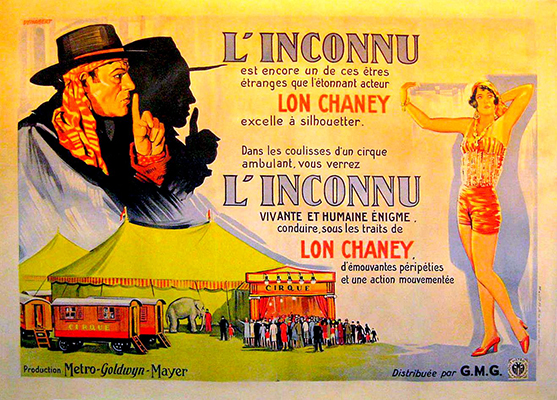
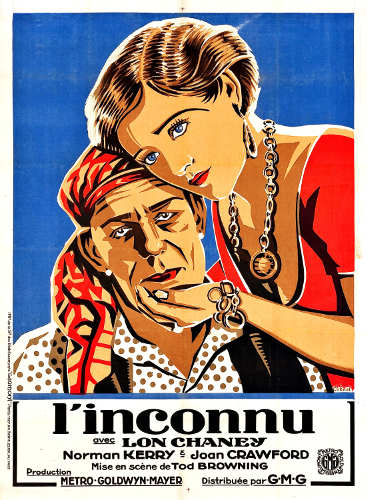
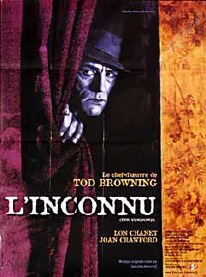
Below: United States
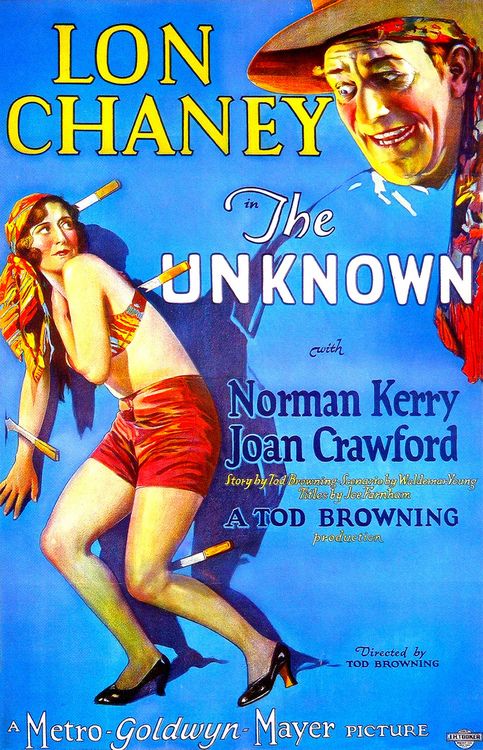
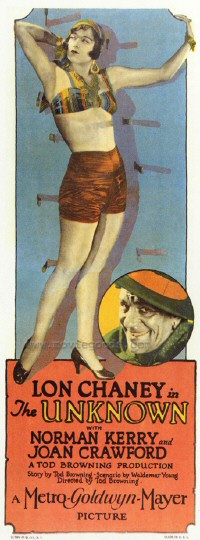
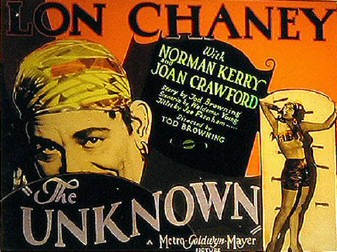

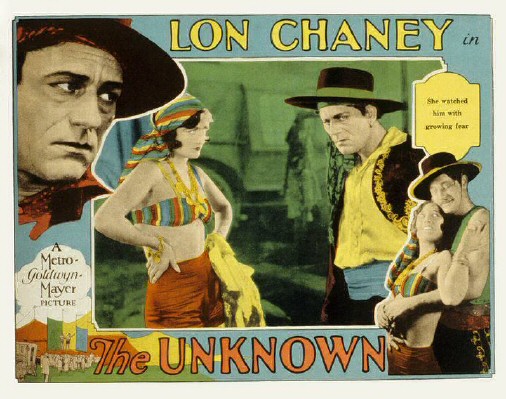
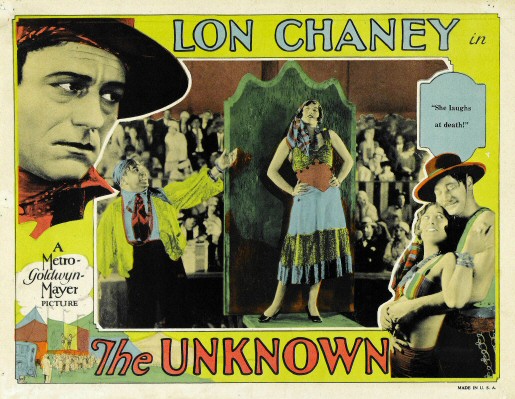



Above: US lobby cards

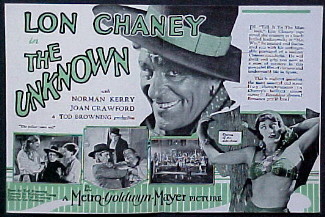
Above: US glass theater slide and US flyer.


Above: US window cards


Above: US ad (Baltimore) and US flyer (Portland)


Below: French publicity material



The Best of Everything